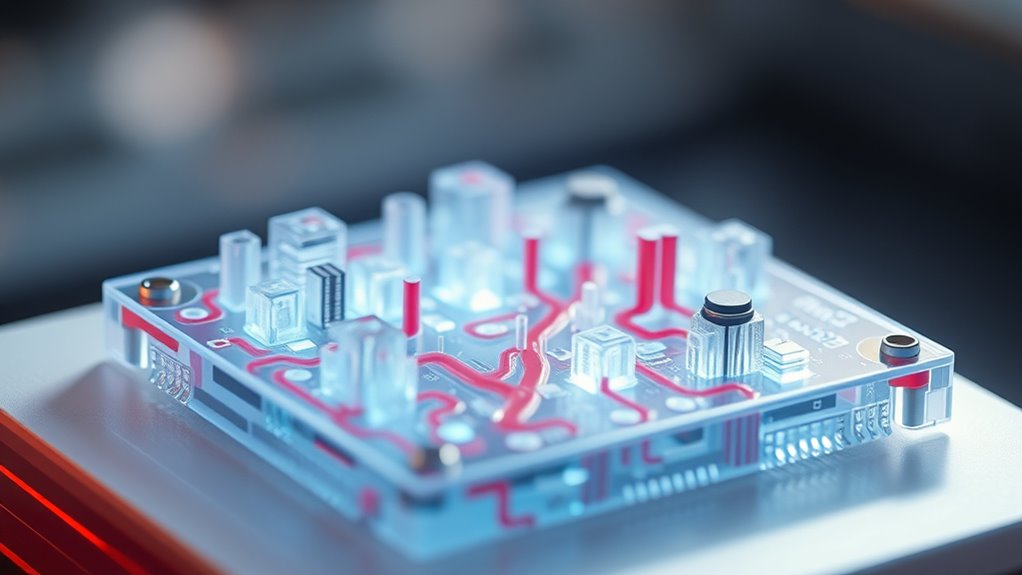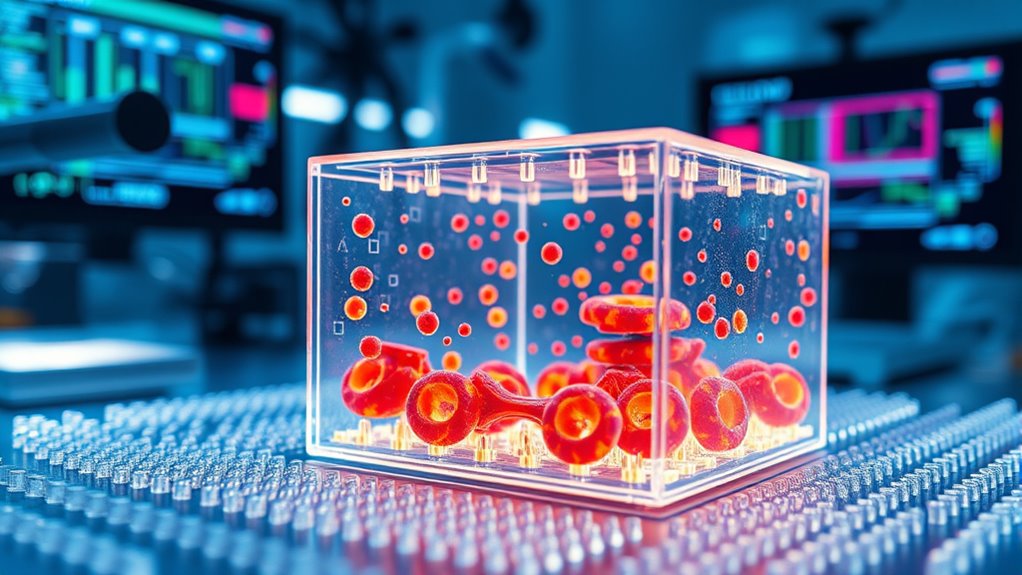Blood-brain barrier chips allow you to test drug permeability without using mice by simulating human BBB conditions in microfluidic devices. These chips feature endothelial cells, tight junctions, and supporting cells to mimic real brain blood vessels. You can introduce compounds, adjust flow rates, and observe how drugs cross the barrier in real time. If you’re curious about how these models transform research and reduce animal testing, there’s more to explore ahead.
Key Takeaways
- BBB chips simulate human blood-brain barrier, enabling drug permeability testing without using mice.
- They allow real-time monitoring of drug passage across endothelial layers in a controlled environment.
- These microfluidic devices help assess drug toxicity and efficacy without animal testing.
- BBB chips can model disease conditions to study drug delivery challenges in neurodegenerative states.
- They accelerate drug discovery by providing ethical, accurate, and cost-effective alternatives to mouse models.

Blood-brain barrier (BBB) chips are innovative microfluidic devices that replicate the complex structure and function of the human blood-brain barrier. These chips simulate how the barrier controls the movement of substances between the bloodstream and the brain, allowing you to study drug permeability in a controlled environment. Unlike traditional methods, which often rely on animal testing, BBB chips give you direct insights into how drugs might behave in the human brain. This approach reduces reliance on mice and offers a more accurate reflection of human physiology.
BBB chips replicate the human blood-brain barrier, enabling drug permeability studies without animal testing.
At the core of these chips are endothelial models that mimic the cells lining the blood vessels in the brain. These endothelial cells form tight junctions, creating a selective barrier that only allows specific molecules to pass through. When you use BBB chips, you can analyze how well a drug can cross this barrier. You simply introduce your drug candidate into the microfluidic system, and observe its passage across the endothelial layer. This process enables you to measure drug permeability precisely, providing real-time data that can inform dosage, efficacy, and safety profiles without the variability introduced by animal models.
The design of BBB chips allows you to manipulate various factors affecting drug permeability, such as flow rates, shear stress, and the presence of supporting cells like astrocytes and pericytes. These components work together to recreate the dynamic environment of the blood-brain barrier, giving you a more extensive understanding of how your drug interacts with the barrier in vivo. As you test different compounds, you can compare their ability to penetrate the barrier, identify potential toxicity issues, and optimize drug properties early in development.
Furthermore, BBB chips enable you to study the influence of disease states, such as inflammation or neurodegeneration, on barrier integrity and drug permeability. By adjusting the conditions within the chip, you can model pathological scenarios and evaluate how they impact drug delivery. This flexibility helps you predict challenges that might arise in clinical settings, improving the likelihood of successful brain-targeted therapies.
In essence, blood-brain barrier chips offer a cutting-edge platform for testing drugs with greater accuracy and ethical responsibility. They allow you to move beyond traditional animal testing, providing detailed insights into drug permeability and endothelial behavior. As a result, you get a powerful tool to accelerate drug discovery, refine candidate selection, and ultimately develop safer, more effective treatments for neurological conditions.
Frequently Asked Questions
How Long Does It Take to Develop a Blood‑Brain Barrier Chip?
Developing a blood-brain barrier chip typically takes several months, depending on its complexity. The manufacturing time varies with the technical complexity involved in designing and assembling the microfluidic components and cell cultures. You’ll need to carefully plan for fabrication, testing, and validation phases. While some simpler models may take around three to four months, more advanced, accurate systems might require up to six months or longer.
Can These Chips Replicate Neurodegenerative Disease Conditions?
You wonder if these chips can replicate neurodegenerative disease conditions, and the answer is yes. They enable neurodegeneration modeling by mimicking disease-specific biomarkers, helping you study disease progression, test treatments, and understand underlying mechanisms. By reproducing key features of neurodegeneration, these chips provide a valuable platform for advancing research, offering insights that go beyond traditional models and bringing you closer to effective therapies.
Are Blood‑Brain Barrier Chips Commercially Available for Research?
You’ll find that blood-brain barrier chips are increasingly available on the market. Several commercial vendors now offer these advanced models for research purposes. They’re designed to simulate the human blood-brain barrier, helping you test drug permeability and neurological disease mechanisms without relying on animal models. Accessibility is growing, making it easier for you to incorporate these innovative tools into your studies and accelerate your research progress.
How Do Chips Compare Cost-Wise to Animal Testing?
They say, “you get what you pay for,” and when comparing costs, blood-brain barrier chips often save you money in the long run. While the initial investment might be higher, they reduce animal testing expenses and ethical concerns. Cost comparison shows chips can be more cost-effective over time, especially considering ethical considerations, quicker results, and fewer regulatory hurdles, making them an attractive alternative to traditional animal-based research.
What Limitations Do Blood‑Brain Barrier Chips Have in Drug Testing?
You should know that blood-brain barrier chips have limitations in drug testing, mainly due to their lower predictive accuracy compared to actual human biology. While they mimic key features, they can’t fully capture the biological complexity of the brain’s environment. This means they might miss certain drug effects or interactions, so results from chips need validation with other methods for more reliable predictions.
Conclusion
Imagine the blood-brain barrier as a delicate, guarded fortress, once tested only by mice’s sacrifice. Now, with these chips, you hold a tiny, transparent key—unlocking new possibilities without harm. This breakthrough symbolizes hope, a gateway to safer, faster drug discovery. As you step closer to understanding the brain’s secrets, remember that these chips aren’t just tools—they’re the bridge to a future where science and compassion walk hand in hand, guarding what’s most precious: our minds.









